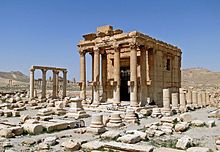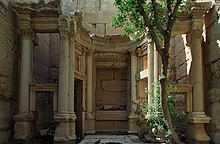Temple of Baalshamin
معبد بعل شمين | |
 The Temple of Baalshamin in 2010 | |
| Location | Palmyra, Syria |
|---|---|
| Coordinates | 34°33′12″N 38°16′12″E / 34.553401°N 38.269941°E |
| Type | Temple |
| History | |
| Material | Stone |
| Founded | 131 AD |
| Cultures | Palmyrene |
| Site notes | |
| Excavation dates | 1954–1956 |
| Condition | Restored, August 2015 |
| Ownership | Public |
| Public access | Inaccessible (in a war zone) |
Arab States | |
| Endangered | 2013–2015 (destroyed) |
The Temple of Baalshamin was an ancient temple in the city of
In 1864, French photographer and naval officer Louis Vignes was the first to photograph the temple following his expedition to the Dead Sea under the sponsorship of the Duc du Luynes.[5]
It was one of the most complete ancient structures in Palmyra.[4] In 1980, UNESCO designated the temple as a World Heritage Site.
In 2015, the
Architectural style

The temple was originally a part of an extensive precinct of three courtyards and represented a fusion of ancient Syrian and
Inscription and dedication
An inscription written in Greek and
The Senate and the people have made this statue to Male Agrippa, son of Yarhai, son of Lishamsh Raai, who, being secretary for a second time when the divine Hadrian came here, gave oil to the citizens, and to the troops and the strangers that came with him, taking care of their encampment. And he built the temple, the vestibule, and the entire decoration, at his own expense, to Baal Shamin and Durahlun.[6]
Damage
Parts of the temple were damaged to some extent by bombings in 2013, during the
Destruction

In May 2015, Palmyra was captured by the
After the temple's destruction, the
Following the recapture of Palmyra by the Syrian Army in March 2016, director of antiquities Maamoun Abdelkarim stated that the Temple of Baalsahamin, along with the Temple of Bel and the Monumental Arch, will be rebuilt using the surviving remains (anastylosis).[23]
See also
- Destruction of cultural heritage by ISIL
- List of heritage sites damaged during the Syrian Civil War
References
- LCCN 2013942192.
- ISBN 0472083155.
- ^ Trombley, Hellenic Religion and Christianization c. 370-529
- ^ ISBN 978-1841623146.
- ^ France Terpak and Peter Louis Bonfitto. "Louis Vignes". The Legacy of Ancient Palmyra. The Getty Research Institute. Retrieved 10 February 2017.
- ^ ISBN 978-1400871391.
- National Geographic News. Archived from the originalon August 28, 2015. Retrieved 28 August 2015.
- ^ a b Ali, Cheikhmous (June 2015). "Palmyra: Heritage Adrift" (PDF). American Schools of Oriental Research. Retrieved 9 September 2015.
- ^ "Islamic State photos 'show Palmyra temple destruction'". BBC News. 25 August 2015. Retrieved 9 September 2015.
- ^ Shaheen, Kareem (27 May 2015). "Syria: Isis releases footage of Palmyra ruins intact and 'will not destroy them'". The Guardian. Retrieved 9 September 2015.
- ^ a b "Palmyra's Baalshamin temple 'blown up by IS'". BBC News. 9 September 2015. Retrieved 25 August 2015.
- ISSN 0362-4331. Retrieved 25 August 2015.
- ^ "المديرية العامة للآثار والمتاحف" (in Arabic). DGAM.gov.sy. Retrieved 25 August 2015.
- ^ Staff (24 August 2015). "Director-General Irina Bokova firmly condemns the destruction of Palmyra's ancient temple of Baalshamin, Syria" (Press release). UNESCO. Retrieved 25 August 2015.
The systematic destruction of cultural symbols embodying Syrian cultural diversity reveals the true intent of such attacks, which is to deprive the Syrian people of its knowledge, its identity and history...this destruction is a new war crime
- ^ Shaheen, Kareem (24 August 2015). "Palmyra: destruction of ancient temple is a war crime, says Unesco chief". The Guardian. Retrieved 25 August 2015.
- ^ Amos, Jonathan (29 August 2015). "Palmyra: Satellite image of IS destruction". BBC News. Retrieved 2 September 2015.
- ^ Sean Higgins. "Oxford Deploying 5,000 Modified 3D Cameras to Fight ISIS". sparpointgroup.com. Archived from the original on 2015-09-23. Retrieved 2015-09-24.
- ^ "The digital race against IS". BBC Radio 4 "Today" programme. BBC. 28 August 2015. Retrieved 24 September 2015.
- ^ Rosenfield, Karissa (1 September 2015). "Harvard and Oxford Take On ISIS with Digital Preservation Campaign". Arch Daily. Retrieved 24 September 2015.
- ^ Mackay, Mairi (31 August 2015). "Indiana Jones with a 3-D camera? Hi-tech fight to save antiquities from ISIS". CNN. Retrieved 24 September 2015.
- ^ Alanna Martinez (September 2015). "Can 3-D Imaging Save Ancient Art from ISIS?". Observer.
- ^ Martin, Guy (31 August 2015). "How England's Institute Of Digital Archeology Will Preserve The Art Isis Wants to Destroy". Forbes. Retrieved 24 September 2015.
- ^ Shaheen, Kareem; Graham-Harrison, Emma (27 March 2016). "Syrian regime forces retake 'all of Palmyra' from Isis". The Guardian. Archived from the original on 27 March 2016.

